可调谐四宽带太赫兹吸收器设计【增强内容出版】
Since the first metamaterial perfect absorber was proposed by Landy et al., it has been widely developed due to its potential applications in the fields of microwave radiation measurement, biosensors, thermal emitters, and imaging. Many existing absorbers face the issue of narrow bandwidths, which fail to satisfy the demands of some optoelectronic devices. To solve this problem, it is common to construct different patterns in the same layer or stack multilayer structures with different geometrical dimensions. However, these structures are often complex, and the absorption rate cannot be actively adjusted. Therefore, phase change materials have been introduced to regulate the absorption rate of absorbents, and vanadium dioxide is one of them. There are many absorbers designed with VO2, but the absorption bandwidth and band number need to be further increased. Therefore, combining the characteristics of multi-band, wideband, and tunable absorption remains a meaningful endeavor.
To effectively study the performance of the absorber, the proposed structure is analyzed by using the microwave simulation software CST Microwave Studio 2020. The metamaterial absorber in this study consists of three layers: the top layer VO2, the middle layer SiO2, and the bottom layer Au. When the conductivity is adjusted from 200 S/m to 2×105 S/m, VO2 will change from an insulator to metal, which can be simulated by input conductivity parameters through the Drude model in CST software. The absorber's absorption can be obtained through one minus the reflection and transmission. Since the penetration depth of the incident wave is smaller than the Au thickness, thus the transmittance is zero. Perfect absorption can be achieved when the reflection is also zero. Material selection and structural design are used to achieve impedance matching, ensuring zero reflection and ultimately realizing perfect absorption of multiple broadbands.
The simulation results show that there are four absorption bands with more than 90% of absorptivity in the range of 0-10 THz, covering bandwidths of 0.87, 0.58, 0.61, and 0.45 THz, respectively. With variations in the conductivity of VO2, the absorptivity dynamically adjusts between 7.7% and 99.9% (Fig. 2). The analysis finds that with the change of dielectric constant of vanadium dioxide, the resonant frequency remains almost constant, while the absorption rate changes significantly. The Fabry-Perot resonance theory and impedance matching theory are introduced to explain the effects of the dielectric layer and the VO2 layer on the absorption (Figs. 3-5). The physical sources of multiple perfect absorption peaks are analyzed through the electric field distribution (Fig. 6). Additionally, changes in absorptivity with different incident angles and polarization angles are analyzed (Fig. 7), which shows that the absorber has the characteristics of polarization insensitivity and wide-angle absorption.
We describe a terahertz absorber with four absorption bands, dynamically adjustable absorptivity, and a simple structure. Simulation results indicate that within the range of 0-10 THz, there are four absorption bands with more than 90% absorptivity, and their respective bandwidths are 0.87, 0.58, 0.61, and 0.45 THz. The absorptivity can be dynamically adjusted between 7.7% and 99.9% by varying the conductivity of vanadium dioxide. The physical mechanism of the absorber is explained using impedance matching theory and Fabry-Perot resonance theory. Through the analysis of the electric field distribution, it is found that the first broadband absorption is mainly caused by the local absorption of VO2, while the second, third, and fourth broadband absorptions result from the resonance absorption of multiple electric dipoles on the surface of VO2, coupled with the coupling effects between the dielectric layer and VO2 and the metal layer. Additionally, it has the features of wide-angle absorption and polarization insensitivity. This absorber has potential applications in micro-radiometers, biosensors, stealth technology, and other fields.
张婷, 郭泰铭, 闫俊伢, 裴娅男. 可调谐四宽带太赫兹吸收器设计[J]. 光学学报, 2024, 44(5): 0523002. Ting Zhang, Taiming Guo, Junya Yan, Yanan Pei. Design of Tunable Four-Broadband Terahertz Absorber[J]. Acta Optica Sinica, 2024, 44(5): 0523002.







